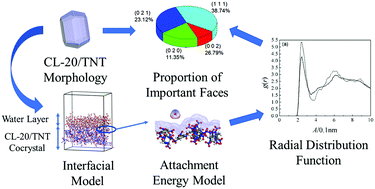Improving the surface hydrophobicity by the solvent effect to reduce the water erosion of the CL-20/TNT cocrystal explosive
Abstract
Explosives should be isolated from the air to reduce the surface erosion by water vapor in the storage and transport processes. The CL-20/TNT cocrystal was chosen as the research object on account of its structural arrangement and weak intermolecular interactions. A relatively extreme assumption that water molecules and the CL-20/TNT cocrystal existed as a solution system on the interface was proposed to investigate the influence mechanism. CL-20/TNT–water interfacial models were constructed, based on four important stable surfaces predicted using crystal morphology theory. The roughness and the electrostatic potential of each surface were analyzed to judge the strength of interactions between the water layer and the cocrystal surface. The effects of the water layer on the crystal surfaces were quantified in terms of binding energy and the radial distribution function using molecular dynamics simulations. Based on the analysis above, the (0 0 2) face was identified as the least affected by water erosion and its growth should be promoted. The crystal morphologies obtained by crystallization in different solvents are significantly different on account of the solvent effect, which can be used to search for a suitable solvent for crystallization to obtain a cocrystal with a larger hydrophobic surface.



 Please wait while we load your content...
Please wait while we load your content...